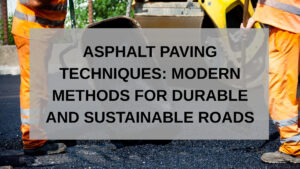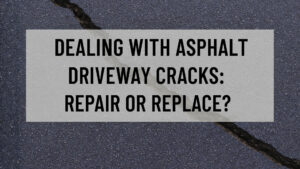Your driveway or parking lot won’t last forever. Rain, sunlight, oil leaks, and heavy cars all wear down asphalt over time. Small cracks can spread into bigger ones, potholes can show up, and the smooth surface can start to bend and break. When this happens, homeowners and businesses usually have two choices: fix the top layer by resurfacing it, or tear it out and replace it completely. This guide will explain what each option means, when it’s the right time to use it, and how to pick the best choice for your property. We’ll keep the language clear and give you solid facts so you can decide with confidence.
What Is Asphalt Resurfacing?
Resurfacing, also called an overlay, means taking off the top layer of asphalt and putting on a new one. Workers grind away the old surface, fix small problems, and lay down about 1½ to 2 inches of fresh hot asphalt on top of the base. Since the base stays in place, resurfacing is faster and less messy than replacing the whole driveway. Most driveways can be resurfaced in just one day and used again soon after.
When Does Resurfacing Work?
Resurfacing isn’t the answer for every driveway or parking lot. It works best on surfaces that are less than 15-20 years old, have a strong base, and only have light damage. Experts usually suggest resurfacing when:
- Only about one-quarter or less of the surface needs fixing.
- Cracks are small, about ¼ inch wide or less, and not very deep.
- The pavement is mostly flat, with no big dips, bumps, or drainage problems.
- The base underneath is solid with no signs of major failure.
If these conditions are met, resurfacing can add 8-15 more years of life to your asphalt. It also makes it look new again. Once the new layer is put down and pressed smooth, you’ll have a dark, even surface that improves curb appeal.
Costs and Benefits of Resurfacing
One of the biggest benefits of resurfacing is the cost. According to HomeGuide, it usually costs $1 to $3 per square foot. For a normal driveway, that’s around $400 to $1,800 depending on its size and where you live. Since the base layer stays in place, resurfacing takes less work and fewer materials. It can also be more eco-friendly because some workers use special heaters to mix the old asphalt with the new, which cuts down on waste.
But resurfacing only fixes the top layer. It won’t repair a weak or broken base, so if the bottom layers are already damaged, the same problems will come back. Resurfacing also doesn’t last as long as a full replacement. You may need to resurface again or rebuild the whole driveway within about 10 years.
What Is Asphalt Replacement (Repaving)
Replacement, also called repaving, means rebuilding the pavement from the ground up. Workers remove the old asphalt, shape the soil so water drains correctly, build a new base layer, add a sticky coating, and then lay down a fresh layer of hot asphalt. This process repairs both surface problems and deeper issues in the foundation.
When Do You Need Replacement?
Repaving is usually needed when:
Cracks are very deep or wide (over half an inch) or there are big potholes that show the base is weak.
More than a quarter of the surface is damaged.
The asphalt is over 20-30 years old.
The pavement is uneven or buckling, which means the base underneath is failing.
The driveway or lot has had many repairs that didn’t last.
If these problems are present, resurfacing would only cover them up for a short time. Full replacement solves the root problem by rebuilding the base. With proper care, a new surface can stay strong and smooth for 20-30 years.
Costs and Benefits of Replacement
Repaving costs more because it needs extra work, heavy machines, and more materials. Prices usually range from $4 to $10 per square foot, and in some places it can be as high as $15 per square foot. For most driveways, this means spending several thousand dollars. Repaving also takes more time since workers have to dig up the old pavement, prepare the base, lay the new asphalt, and let it cure.
Even though it costs more, replacement has big long-term benefits. By fixing problems in the base, you avoid constant repairs. A brand-new asphalt surface is stronger and can handle heavy cars and tough weather much better than a weak base with patchwork fixes. For homeowners who plan to stay in their home for many years, or businesses with lots of traffic, repaving is often the smarter and more cost-effective choice over time.
Resurfacing vs. Replacement: A Side‑by‑Side Comparison
| Factor | Resurfacing | Replacement |
| Cost | $1-$3 per sq. ft. | $4-$10 per sq. ft. or more |
| Longevity | Adds 8-15 years | Lasts 20-30 years |
| Scope of Damage | Works when damage is small and the base is solid | Needed for widespread or structural damage |
| Disruption | Quick process, less disruptive | Takes longer, more disruptive |
| Environmental Impact | Reuses the base and sometimes old asphalt | Needs more raw materials and creates more waste |
How to Decide: Key Factors
Deciding between resurfacing and replacing depends on your budget, the amount of damage, and your long-term plans. Ask yourself these questions:
- How bad is the damage? Take a walk around your driveway or parking lot. If cracks are small and shallow, resurfacing may be enough. But if cracks are wider than half an inch, go deep, or the surface is uneven and bumpy, the base may be failing and replacement is the better choice.
- How old is the pavement? Asphalt usually starts breaking down after about 20 years. Adding a new layer to very old pavement won’t last long because the base is already weak.
- Are there drainage problems? If water collects and sits on the surface, it can make the pavement wear out faster. Replacement lets workers reshape the ground to fix drainage, but resurfacing cannot.
- What is your budget? If you don’t want to spend much or plan to sell soon, resurfacing gives a fresh look for less. If you plan to stay for many years and can pay more, replacement is stronger and lasts decades.
- What are the long-term costs? Paying for resurfacing and small repairs again and again may cost more over time than replacing the whole driveway once. A trusted contractor can give you estimates for both choices.
Care After Repair
Taking care of your asphalt can make it last much longer:
- Seal it often: Put on a protective seal every few years to block damage from the sun and rain.
- Keep it clean: Sweep away dirt and trash, and clean up oil spills as soon as you see them.
- Fix small cracks fast: Filling little cracks right away keeps water from soaking in and making bigger problems.
- Watch drainage: Make sure gutters and yard water flow away from the pavement, not onto it.
These steps are simple but make a big difference in preserving your investment.
Frequently Asked Questions
1. When is resurfacing a suitable choice over replacement?
Ideal when the foundation is still solid, damage is superficial (fading, small cracks), less than 25-30% of the surface needs work, and the pavement is generally under 20 years old
2. Who should I call for asphalt paving near me?
Tex Pave Experts which are Asphalt Paving Contractor Near Quinlan, Texas making it easy for users looking for local asphalt services.
3. Under what conditions should I opt for complete asphalt replacement?
Necessary for severe issues like deep cracks, major potholes, failed foundation, or when recurring repairs aren’t holding up
4. How do resurfacing and replacement compare in terms of cost, longevity, and convenience?
Resurfacing is typically less expensive and faster, extending pavement life by several years. Replacement costs more and takes longer but offers a longer-lasting, structurally sound result and reduces long-term maintenance



